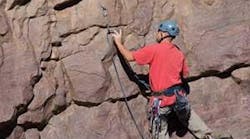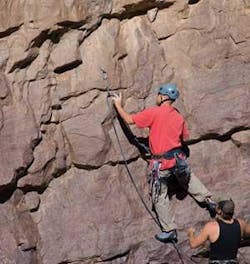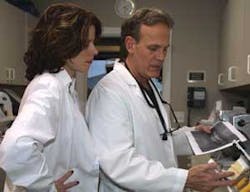For more on this topic, go to www.dentaleconomics.com and search using the following key words: Accreditation, AACD, American Association of Cosmetic Dentistry, examiner.
by Michael R. Sesemann, DDS, FAACD, and Karry K. Whitten, DDS
When I have time to get away, I truly enjoy hiking in our national parks. In my younger years, these hikes often were teamed with climbing what is termed a "thirteener or fourteener." Climbing necessitates an accompanying mental adjustment. Rather than simply passing through nature and enjoying its essence, considerably more mental and physical effort must be summoned to be safe and successful.
Much like the sport of climbing, there are certain risks in dentistry that one accepts when going vertical regardless of the degree of verticality. There are times when you decide to do something you have never done previously. You attempt a degree of difficulty that you have never tried — one that will challenge you to do your best. When this type of adventure confronts you, a challenge that introduces new tasks and learning, there is a simple way to reduce risk and increase the chances for success. You need to enlist the counsel of someone who has been there.
Associate Wanted
There. I said it. "Associate Wanted." I anxiously waited for my staff"s response. Certainly they would bring up the other two times we had been unsuccessful at integrating the right person. The first dentist left the area because he wanted to return home to be close to family. The second attempt ended when the dentist accepted a position from the Mayo Clinic.
There had been difficulties assimilating both of these associates into the practice. The staff often found that patients resisted being scheduled for dentistry with anyone but me. The principal reason for this reluctance was that I am the only dentist in our state who is Accredited with the American Academy of Cosmetic Dentistry.
Many patients find our practice through the AACD Web site or come to us specifically for the expertise they think I have gained via the Accreditation process. Knowing that I am a dentist who has passed a stringent examination process in cosmetic dentistry, they choose to wait for an available appointment with me instead of scheduling with my associate at an earlier time.
The difference in Accreditation status between my associate and me resulted in the staff dealing with much extra dialogue throughout the day. They had to launch into scripted language to assure patients that my associate could perform the proposed treatment in an excellent manner.
I knew that answering those questions added to their daily stress and made their jobs more difficult, so I quickly explained to the staff that this time we would look specifically for a practitioner who had the commitment and drive to pursue the same training that we had completed. Because of our niche in the community, we wanted someone who would develop a similar skill set and reputation. We needed to find someone who wanted to become Accredited.
Hopefully, this could set up a "win-win-win" scenario for all parties. Obviously, I would get someone to help with my workload, especially during the increasing time that I am required to spend away from the office for lecturing and AACD obligations.
I enjoy teaching a great deal, and because of my experience as an Accreditation examiner, I could mentor a person who is going through the Accreditation process (Fig. 1). Currently, I do this for many people via the Internet like many examiners do; however, it would be fun and an efficient use of time to mentor someone in person in the office (Fig. 2).
A dentist could benefit greatly from this type of mentoring. If the person has designs on becoming Accredited, it would obviously be beneficial to learn from someone who has been through the process.
He or she would have a mentor who could cast a quick look at a case in order to determine its ability to stand up to the Accreditation examination criteria. He or she would also have a person who could lend moral support. The mentor could explain that there are hills and valleys in the process, and affirm that it is the person who is willing to get the process done — to finish no matter what — who eventually will have a better chance for success.
Finally, the patients at my practice would have the benefit of another AACD Accredited dentist in the office and community. In addition, the staff would not have to field questions related to an associate"s background and skills. If queried, the staff could express confidently that the associate had achieved Accreditation.
So I immediately contacted specialists in our area to find the person who possessed the personality traits that would fit with our practice and who possessed the skills to successfully tackle the Accreditation examination.
Fortunately, we heard about someone who had recently changed the way she was practicing and was looking for the right place to utilize her skills. A couple of years earlier, this person had sold a practice to decrease business hours so she could devote more time to her young family.
What began as friendly conversation during a lunch hour soon became a serious discussion about the possibility of working together. After additional discusssion to identify each other"s objectives, it seemed only appropriate to invite Dr. Karry Whitten to join the practice. Accreditation was one of the strong bonds that would anchor our new alliance.
Dr. Whitten's perspective
When I was in dental school, I heard someone say that we go to school to graduate and then eventually own a practice. For me, this statement was the goal from the beginning. I wanted to practice as I wished and choose patients and staff that best fit my plans. I also wanted to be my own boss. Some 10 years ago, I started a practice shortly after graduation from dental school.
To be prudent and to make sure I was making the right decision, I looked at different options available to a new graduate. These included buying an existing practice, becoming an associate, or starting from "scratch." Other options were not especially appealing to me.
Given the school debt that I had, the thought of spending a quarter of a million dollars on an existing practice did not seem feasible nor did it seem economically responsible. I also had a difficult time finding someone with whom I thought I could work and from whom I could learn. After much debate and research, I took the leap and started a new practice.
As time passed, I found myself calling my stepfather (who is also a dentist) for advice. I realized I did not know as much as I thought I did. Patients were walking into my office asking for veneers and crowns to improve their smiles.
Since I had completed only one veneer preparation on a dentaform in dental school, I believed that I needed more education. I began by attending a series of weekend courses that focused on esthetics and smile design. I went to hands-on courses and listened to a variety of lecturers.
The more I learned, the more I realized that there was so much more to learn. Also, the longer I practiced, the more I began to see some failures in dentistry. I wanted to find the answers to the many questions that I was having. I wanted to find a way to create a systematic approach to treatment planning and smile design, so there would be more predictable long-term results.
At this time in my life, my husband and I were trying to increase the size of our family. It was becoming increasingly difficult to balance family life with running a practice and focusing on learning. I decided to sell my practice and devote time to my young family and learning.
After taking some time off, I decided to pursue an associateship under someone from whom I could learn and grow without the added pressures of running day-to-day business affairs.
>My commitment to patient care and the desire for professional growth drove me to meet with a specialist in town whom I trusted. After discussing some of my goals, he recommended that I meet with Dr. Sesemann. He thought we might be fairly compatible based upon our similar goals for excellence in patient care and treatment.
It wasn't until sometime later, though, that Dr. Sesemann and I met. We met several times to discuss our aims and ideals. We both wanted this to be a cohesive and durable alliance. I believe that having practiced for a few years gave me the perspective that a new graduate might not have: the need for, and appreciation of, someone in your professional life who is willing to invest in you.
Clinically, I had been searching for a way to challenge myself and fulfill criteria that call for excellence. AACD offers that opportunity. This challenge is one of the greatest clinically based treatment accomplishments that I have ever wanted to achieve.
Having started this process, I think that it drives me to become a better clinician. The Accreditation process gives Dr. Sesemann and me a shared platform for discussing cases. The knowledge I am gaining gives us consistency while practicing together.
I have been greatly encouraged by the progress I am making. Since Dr. Sesemann and the majority of his staff have been though this learning process already, their knowledge is a great benefit. I am learning so much from them. For example, I am amazed at how the use of photography helps to show ways in which I can improve my dentistry. I am fortunate to be part of a practice in which the Accreditation protocol already exists and is a shared value. The staff is a vital and integral part of this accomplishment.
This painstaking process has been a humbling experience, too. Working with Dr. Sesemann through a teaching-learning protocol has created an excellent environment for professional growth. In such an environment, one is driven to become a better clinician, and the desire to improve is nurtured and encouraged. The satisfaction one has at the end of the day contributes to the important balance with one's personal life. Working toward Accreditation with a skilled practitioner is a challenging road, but a welcome one. It is one that I would recommend to anyone with the desire to learn and grow professionally toward excellence.
Conclusion
Accreditation has long been valued as more than a credential. It is about the journey of learning that transforms the Accreditation candidate into a better dentist or lab technician, and provides important benefits for him or her, the staff, and patients or clients.
There is also a consensus that Accreditation is a steep road to climb, particularly if you have never been on this path. One of the best ways to scale the "peak" of Accreditation is to seek the counsel of someone who has already climbed this particular mountain (Fig. 3). Together, the experience of one and the wholehearted commitment of another can exponentially improve your chances for clinical excellence, satisfaction, and success.
Dr. Michael Sesemann is an Accredited Fellow of the American Academy of Cosmetic Dentistry. He serves the Academy as an Accreditation and Fellowship examiner, along with responsibilities as AACD Vice President. Besides practicing full-time in Omaha, Neb., Dr. Sesemann lectures internationally and serves on several editorial boards of peer-reviewed publications. Recently, he was named associate editor of Functional Esthetics and Restorative Dentistry. Contact him via the Web at www.smilesonline.net or call (402) 392-2880.
Karry Whitten, DDS, graduated from the University of Nebraska College of Dentistry in 1997. She came to the Nebraska Institute of Cosmetic Dentistry with nine years of experience as a dentist. During that time, she established a practice where she worked for seven years. After the arrival of her second child, Dr. Whitten sold her practice to focus on family and professional growth. She then joined Dr. Michael Sesemann at the NICD. Contact Dr. Whitten at (402) 392-2880.










